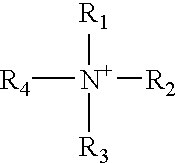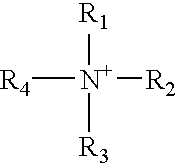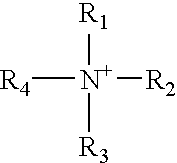Multi-component barrier polishing solution
a technology of barrier polishing and multi-components, applied in the direction of polishing compositions with abrasives, other chemical processes, chemistry apparatus and processes, etc., can solve the problems of low-k dielectric control, conventional bulk copper removal slurries are not useful for barrier applications, etc., and achieve the effect of reducing the removal rate of nonferrous interconnect metals
- Summary
- Abstract
- Description
- Claims
- Application Information
AI Technical Summary
Benefits of technology
Problems solved by technology
Method used
Image
Examples
example 1
[0041] The polishing was performed using a Mirra® model polishing tool manufactured by applied Materials. The polishing pad was a Politex™ High E porous polyurethane pad supplied by Rohm and Haas Electronic Materials CMP Technologies. The pad was conditioned prior to each run with a diamond abrasive plate manufactured by Kinik having 180 μm diamonds. The polishing process was performed at a membrane pressure of 10.33 kPa (1.5 psi), a table speed of 93 revolutions per minute (rpm) and a carrier speed of 87 rpm. The polishing composition supply rate was 200 ml / min using 200 mm blanket wafers from ATDF, Inc. Cu and TaN removal rates were measured on a Four-Point Probe CDE Resmap. Copper, TaN, TEOS and Coral® carbon-doped oxide (CDO) film removal rates were measured by a ThermaWave Optiprobe®) 2600 metrology tool and an OrbotTM WF-720 from Applied Materials measured defectivity. Tables 1 to 4 below provide the polishing results.
TABLE 1BTAH2O2SilicaTBAHTaNTEOSCDOCuSample(wt %)(wt %)pH(...
example 2
[0046] The polishing was performed using a Strasbaugh model 6EC polishing tool. The polishing pad was a Politex™ porous polyurethane pad supplied by Rohm and Haas Electronic Materials CMP Technologies. The pad was conditioned prior to each run with a diamond abrasive plate manufactured by Kinik having 180 μm diamonds. The polishing process was performed at a membrane pressure of 10.33 kPa (1.5 psi), a table speed of 93 revolutions per minute (rpm) and a carrier speed of 87 rpm. The polishing composition supply rate was 200 ml / min using 200 mm blanket wafers from ATDF, Inc. Cu and TaN removal rates were measured on a Four-Point Probe CDE Resmap. Copper, TaN, TEOS and Coral® carbon-doped oxide (CDO) film removal rates were measured by a ThermaWave Optiprobe® 2600 metrology tool and an Orbot® WF-720 from Applied materials measured defectivity. Tables 5 below provides the polishing results.
TABLE 5Zonyl FSPSurfactantSilicaH2O2TaCuTEOSCDOSlurry(wt %)(wt %)(wt %)Final pH(Å / min)(Å / min)(Å / ...
PUM
| Property | Measurement | Unit |
|---|---|---|
| Fraction | aaaaa | aaaaa |
| Percent by mass | aaaaa | aaaaa |
| Percent by mass | aaaaa | aaaaa |
Abstract
Description
Claims
Application Information
 Login to View More
Login to View More - R&D
- Intellectual Property
- Life Sciences
- Materials
- Tech Scout
- Unparalleled Data Quality
- Higher Quality Content
- 60% Fewer Hallucinations
Browse by: Latest US Patents, China's latest patents, Technical Efficacy Thesaurus, Application Domain, Technology Topic, Popular Technical Reports.
© 2025 PatSnap. All rights reserved.Legal|Privacy policy|Modern Slavery Act Transparency Statement|Sitemap|About US| Contact US: help@patsnap.com



